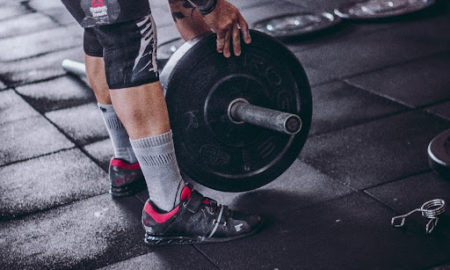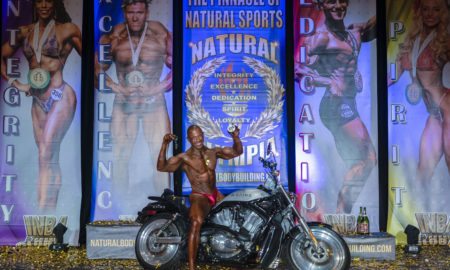Testosterone is perhaps the most remarkable substance in our bodies. It has been offered as an explanation for all the infamies of mankind—like why they start street fights and civil wars, throw chairs across the room during sporting events, drive too fast, grunt, yell and essentially attempt to conquer whatever is in their reach. Hey, what’s not to like?
As bodybuilders, however, we’re chiefly concerned with the hormone’s anabolic properties. Without it all our efforts in the gym would be severely hindered. In fact, decreasing testosterone by just 10 percent severely blunts gains in strength and muscle growth.1
Testosterone counts generally increase after each training session and may change over a given training year. The critical point, however, is that we can manipulate the rise of testosterone by varying intensity and volume as well as the exercises we do during a workout.
What Is Testosterone, and How Is It Regulated?
Testosterone is an anabolic, androgenic steroid hormone, which, like other steroid hormones, is derived from cholesterol. It’s critical to distinguish between its anabolic and androgenic properties. The anabolic characteristics are what bodybuilders are interested in and refer to testosterone’s capacity for increasing muscle tissue. Its androgenic properties refer to the hormone’s capacity for stimulating secondary sex characteristics in males—deepening of the voice, body hair growth, etc.
In males the majority of testosterone is produced in the testes in specialized cells known as the interstitial cells of Leydig, while in females it is produced primarily in the adrenal glands. Control of testosterone release begins in a region of the brain called the hypothalamus, which releases gonadotropin-releasing hormone. That travels directly to the anterior pituitary gland, where it stimulates the release into the bloodstream of luteinizing-hormone, which stimulates the production and release of testosterone from the testes.
The brain’s release of testosterone can be affected by all sorts of factors, including stressors such as exercise and how many calories an individual is taking in. Ultimately, it’s important to realize that the amount of testosterone in the blood regulates its release. If testosterone counts are too high, such as when the hormone is administered, the brain lowers the release of gonadotropin-releasing hormone and luteinizing hormone, which ultimately lowers testosterone production in the testes. Finally, testosterone can be converted to estrogen. When estrogen counts are too high, testosterone release is inhibited.
Effects of Testosterone on Muscle Mass and Performance
The use of testosterone as a performance-enhancing aid can be traced to at least as far as the ancient Olympic Games in 1776 B.C., where some competitors actually ate the testes of bulls. It was also known in the earlier part of last century that castration caused a loss of muscle tissue and strength.
It was not until recently, however, that controlled scientific studies were conducted on the effects of testosterone on muscle growth and strength. In a beautifully designed study that illustrates the effects of testosterone, scientists found that increasing circulating T by a factor of 4.6 led to experienced weightlifters making gains in total muscle mass and triceps and quadriceps girth, as well as weight lifted in the squat and bench press, without working out for 10 weeks.2 Then, when they started training again, the gains were much greater.
A more recent study found that three bouts of resistance training increased muscle protein and that the growth adaptation was paralleled by an increase in both testosterone and its receptors.3
How Testosterone Works
So how exactly does testosterone work to increase strength and muscle tissue? That question has been pondered for some time by the scientific community. One of the major hypotheses is that testosterone is able to directly stimulate protein synthesis, or the building of muscle tissue, by binding to the nucleus of a muscle cell. In fact, studies show that when you block testosterone from binding to the cell nucleus by blocking its receptor, you suppress muscle growth following exercise.4 Another primary way testosterone may work is by increasing various growth factors in the muscle, such as insulinlike growth factor 1.
Finally, testosterone may inhibit cortisol, a hormone responsible for stimulating the breakdown of muscle tissue, which is the opposite of what bodybuilders want.5 Studies show, however, that testosterone actually blocks the binding of cortisol to the cell nucleus, thereby lowering its antibodybuilding effects.
What’s the Best T-Triggering Intensity and Volume?
Volume is defined as total work done—that is, the total amount of sets per workout—and there appears to be a volume threshold for testosterone secretion. For example, researchers found that 10-repetition sets of squats did not increase testosterone until the fourth set, suggesting that a volume threshold may exist.
When people talk about intensity, they usually mean how hard they push themselves or the magnitude of their focus in the gym. When exercise scientists discuss intensity, however, they mean a percentage of a maximal output. For example, if you can bench-press 200 pounds, then 160 pounds would represent 80 percent of your max. One study compared the effects of 10 sets of 10 repetitions at 70 percent of the subjects’ one-rep maximum to 20 sets at 100 percent of one-rep maximum on testosterone release following exercise.3 While researchers found large changes in testosterone following the moderate-intensity protocol, no significant increases were found after numerous sets performed at 100 percent intensity. This suggests that bodybuilders may benefit from lifting in a moderate repetition range of eight to 12.6
It appears the greater rise in testosterone may be the result of greater metabolic stress, such as increases in lactic acid following moderate-intensity, rather than maximal-intensity, training. From these studies we can conclude that moderate intensity, high-volume exercise—eight to 12 reps and more than four sets—leads to greater increases in testosterone than low-volume, maximal-intensity exercise.
Intensity within a set can also affect testosterone release. Researchers had subjects perform three sets of three repetitions each on back and front squats and three sets of six repetitions on leg extensions.7 They did the exercise either at 100 percent of their intensity or at 70 percent intensity for the given repetition range. For example, if an individual could lift 100 pounds for six repetitions and not get another rep, that is 100 percent intensity, whereas 70 percent would be 70 pounds. Individuals who performed at 100 percent intensity had greater increases in testosterone than those who performed at 70 percent intensity. The take-home message is, go hard or go home!
How Exercise Selection Influences Testosterone
The choice of exercise appears to affect the testosterone increase to muscle tissue. For example, a study examined the effects of five sets of 10 repetitions of bench press vs. five sets of 10 explosive squats, with two minutes’ rest between sets, in 12 resistance-trained men.1 Testosterone was higher following the squats (15 percent) than following the bench presses (7 percent), suggesting that exercises that recruit the most substantial amounts of muscle tissue optimize testosterone release. It lends credence to the idea of doing “mass exercises,” such as squats or bent-over rows, first before performing leg extensions or dumbbell pullovers, as the former two would have greater effects on changes in the hormone environment.
Long-Term Adaptations to Testosterone
Two key studies summarize what we know about chronic adaptations to testosterone. In one scientists analyzed 24 weeks of strength training at 60 to 80 percent of one-rep maximum.9 Testosterone rose at eight weeks, dropped at 16 weeks and was back to baseline at 24 weeks. Based on the study, it appears that testosterone increases early in a training program, but by the end of the program it returns to baseline.
The second study investigated the effects of 24 months of training in elite weight trainers and found that testosterone was increased at the end.10 So why did the groups get different results? One view is that heavy training results in hormonal changes; however, it is possible that when athletes adapt to such training, as perhaps with the first group, it’s no longer enough to stimulate growth, and the changes disappear.11
In the second study the elite athletes continually changed their training style and load, so their bodies did not have a chance to adapt. The takeaway is that bodybuilders need to periodize their training.
The Power of T
Testosterone is a powerful hormone capable of stimulating muscle tissue and strength gains. It is increased maximally with moderate-intensity and relatively high-volume exercise, compound movements and failure training. Lastly, when individuals let their program become stagnant, their testosterone drops. You can see the need for emphasizing the importance of periodizing training.
Editor’s note: Jacob Wilson is a professor of exercise science and researcher in the department of Exercise and Sports Sciences, at the University of Tampa, Florida. He is also president of the Web site ABCBodybuilding.com. Gabriel Wilson is a Ph.D. candidate in nutrition in the Division of Nutritional Sciences at the University of Illinois, Urbana-Champaign. He is researching optimal protein requirements for muscle growth. He is also vice president of the Web site ABCBodybuilding.com.
References
1 Alen, M., and Rahkila, P. (1988). Anabolic-androgenic steroid effects on endocrinology and lipid metabolism in athletes. Sports Med. 6(6):327-332.
2 Bhasin, S., et al. (1996). The effects of supraphysiologic doses of testosterone on muscle size and strength in normal men. N Engl J Med. 335(1):1-7.
3 Willoughby, D.S., and Taylor, L. (2004). Effects of sequential bouts of resistance exercise on androgen receptor expression. Med Sci Sports Exerc. 36(9):1499-1506.
4 Inoue, K., et al. (1994). Androgen receptor antagonist suppresses exercise-induced hypertrophy of skeletal muscle. Eur J Appl Physiol Occup Physiol. 69(1):88-91.
5 Salehian, B., and Kejriwal, K. (1999). Glucocorticoid-induced muscle atrophy: Mechanisms and therapeutic strategies. Endocr Pract. 5(5):277-281.
6 Hakkinen, K., and Pakarinen, A. (1993). Acute hormonal responses to two different fatiguing heavy-resistance protocols in male athletes. J Appl Physiol. 74(2):882-887.
7 Raastad, T., et al. (2000). Hormonal responses to high- and moderate-intensity strength exercise. Eur J Appl Physiol. 82(1-2):121-128.
8 Volek, J.S., et al. (1997). Testosterone and cortisol in relationship to dietary nutrients and resistance exercise. J Appl Physiol. 82(1):49-54.
9 Hakkinen, K., et al. (1985). Serum hormones during prolonged training of neuromuscular performance. Eur J Appl Physiol Occup Physiol. 53(4):287-293.
10 Hakkinen, K., et al. (1988). Neuromuscular and hormonal adaptations in athletes to strength training in two years. J Appl Physiol. 65(6):2406-2412.
11 Kraemer, W., et al. (1996). Strength and power training: Physiological mechanisms of adaptation. Exerc Sport Sci Rev. 24:363-398. IM
















You must be logged in to post a comment Login